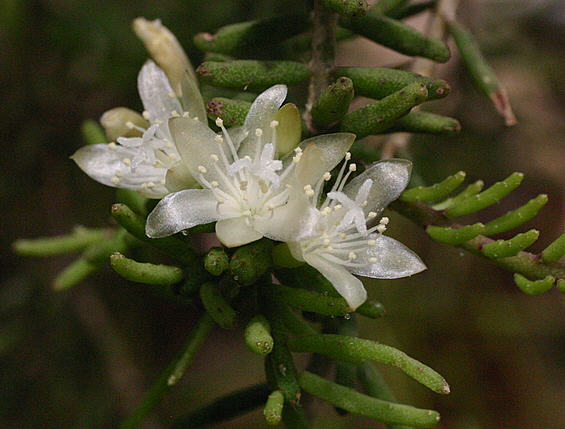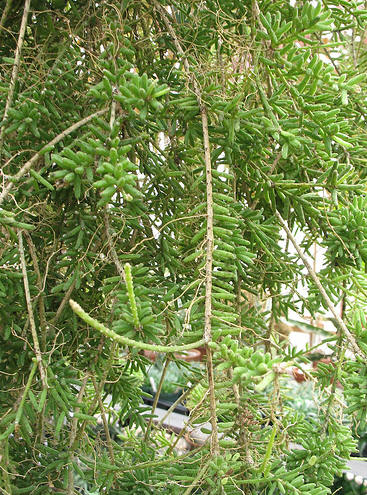| Rhipsalis mesembryanthemoides Haworth, Rev. Pl. Succ. 71. 1821 | |
|
|
This pencil type is easy to identify because it is the only Rhipsalis
made up almost exclusively of stems lined with tightly packed tiny
branchlets. White flowers; white fruit. Branches - very dissimilar; main branches elongated, slender,
terete, more or less setose, often bearing aerial roots, covered with
short stubby branchlets; these sometimes also bearing short joints,
usually less than 1 cm. long, more or less angled, often with short
setae from the small areoles; The etymologically correct and commonly used spelling of this epithet is employed above. Haworth's original spelling being treated as an orthographic error. De Candolle in Prodromus Systematis Naturalis Regni Vegetabilis 3 : 475-476. 1828 (page 476). 5. R. MESEMBRYANTHOIDES (Haw. rev. 71.) glomerato – ramosa, ramis erectisteretibus strictis articuliferis, articulis lateralibus confertis teretibus utrinquè attenuatisnebulosis medio floriferis, fasciculis setarum capillicearum albis pallidis demùmmortuisve nigris, floribus solitariis. ? in Americâ merid. R. salicornioides ß Haw. suppl.83. Articuli ad ramorum latera numerosi conferti suberecti. Flores è medio (nec apice)articulorum parvuli albi. Bacca alba R. cassythae. (Salm-Dyck in litt.)English Translation Plant with branches close together, branches erect , tubular, jointed close together, lateral joints on both sides compactly terete, tapering gradually, bearing flowers with a clouded middle, clusters of bristly hairs, pale white later more or less black. Flowers solitary. Grows in Southern America. Joints to lateral branches, numerous, compactly sub erect. Flowers small white, in middle (not at top) of the branches. Fruit white. Treated as R. mesembryanthemoides by B&T in Bradleya 13
|

